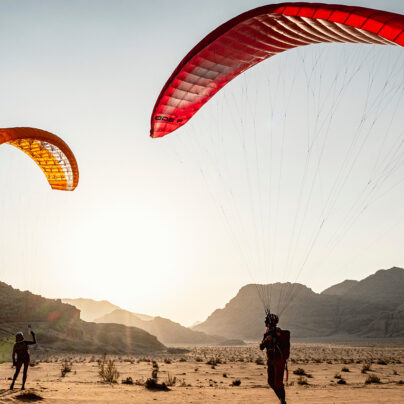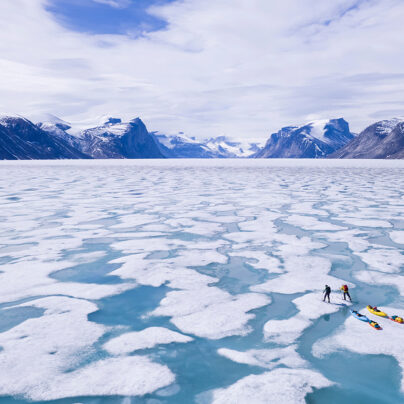The Shining Wall
Words: Andy Knight // Photography: Jeremiah Watt
It began with a phone call from Scott. ‘Dude,’ he said, ‘you gotta get down to Zion. Like now. There’s way more ice than anyone thinks.’ He always spoke like that when it came to ice, with urgency and need.
What started out as a photo shoot on the only ice route in Zion at the time, the Zicicle, became a search for whatever else might be hanging around the canyon. As it turned out, Scott was right: there was more ice out there. It was just a little further on along the canyon’s rim and took some finding. Finding it was one thing, climbing it quite another.
For most climbers, when they hear about ice in Zion, climbs like Moonlight Buttress and other similar routes on the massive Navajo Sandstone walls come to mind, towering hundreds of metres overhead with long blue smears of ice running down them. Busy, crowded routes. Too much time spent waiting in line. But that’s only the main canyon of Zion, its most famous attraction, and the least likely place to find climbable pitches of ice. Scott was headed higher up, to the backcountry of Zion National Park and its boundaries. Out there, way up on top of the highest rock layers of the main canyon, lies a vast network of deep canyons that run for miles, each cut by endless side drainages, all feeding back into the main Zion Canyon. Approaching from above, you peer over the rim, looking down into a dark abyss of smooth, curved walls that seem to dance with each other, at times almost touching. Ice flows from the tops of these canyon walls. One benefit is that you can always rappel down the route and check it out, seeing how far down the ice goes and if it’s thick enough to climb all the way. Thing is, once you’re at the bottom, and you decide to pull ropes, you’re committed to climbing back out. All of a sudden the climbing gets real.




Most of what Scott and those who joined him had explored around the Zicicle lies along Orderville Canyon, on the east side of the park. Of the other big canyons, Kolob Creek on the west side looked to them like the next promising site. After finding a few good lines along the main creek canyon, they decided to venture over to a larger side canyon that joined at a confluence further down. There they stumbled upon one of their greatest finds yet, the Shining Wall. Fanning out before them was a shimmering blue lattice of highly concentrated ice lines, over 100m in length and all spring-fed from the rim. It wasn’t hyperbole to call it the Holy Grail of Zion ice climbing. Caution threaded their excitement. Temperatures were rising. Most of the lines were already halfway melted out on top. One, however, looked good enough to attempt. Last Man Standing became the last route of their two-week sending spree. The next day the sun won over the last of the ice, leaving only the dreams of what the next season might hold.
When that second season did come around, Scott’s attention focused unwaveringly on returning to the Shining Wall. We found the wall barely in good enough condition to climb. It was thin but, we thought, climbable. Scott knew exactly which flows he wanted to hit first. Right in the centre of the wall is a drip that spills over the edge of the cliff, running a few metres down and then over a steep overhang that creates a beautiful skinny pillar of ice 30m high. The water hits a series of ledges that split the flow into two stretched-out, taffy-like smears that run a good 50m down to the canyon bottom. This was one of the most striking lines on the whole wall. Well over 100m of beautiful, thin ice, with the crux waiting near the top.
On arriving at the narrow canyon bottom, however, perspective shifts. Suddenly, the climb out appears much more intimidating. But the only way out is back up. Matt Tuttle, returning with Scott, stepped up for the first pitch, which was a long, thin streak of cloudy blue on the right-hand side, capped off by a big roof. The only way up was to traverse left across the smooth sandstone to another long smear that ran up to the ledges above. Matt climbed through, relying on precision and balance for tricky foot placements on sloping scallops. Few holds good enough for an axe meant he had to holster a tool and grab the subtle features with his hands to traverse the rock. When he reached the ice again, he cried out he was so relieved. More cruiser ice led up to the ledges and the bottom of the steep crux pillar. Standing there at the belay, Scott took little time to ready himself before heading up. His cry of jubilation when he completed the pitch echoed through the canyon. Ours soon followed.




Most people would have called it a day and savoured the victory. Not Scott – he was ready to gear up and move to the right side, where he’d seen a classic line with ice that ran down the wall like a smooth highway, narrowing to a skinny pillar at the bottom. But on the way down, he kept kicking the ice, checking to make sure it was actually attached to the wall. On the second rappel down, 30m from the bottom, the ice gave a deep hollow sound as he kicked it. The rest of the climb to the bottom wasn’t really attached. We put in an anchor just above, and pulled ropes before the climb back up. Scott offered me the lead. With not much room to move, I had to be careful while climbing right above Matt and Scott, trapped on a hanging belay, dangerously exposed to any falling ice I broke off with my swings. After stretching out the rope and all my screws, I put in another hanging belay and brought them up. Scott sped up the remaining pitch just as the light faded. As the setting sun cast its fire over the glistening ice, we knew we would return next season – for a try from the bottom. It just needed a little more time to freeze.
The future of new ice ascents in Zion remains something of a mystery. There’s no shortage of places where water can run over a cliff. Given the right conditions, ice might form where it is least expected and in ways that make climbing it completely unique. With just two of the five major drainages explored, the question isn’t about if there is ice, but who is willing to find it. And who will climb it.
This story was first published in Sidetracked Magazine Volume 14
In memory of Scott Adamson – an incredible human and accomplished climber lost on Ogre II, Pakistan, in August 2016. One of Scott’s passions was finding and climbing Zion ice. He spent many hours studying maps and many days seeking out the fickle, ethereal huge pillars hidden within remote slot canyons. He left us with love, bold passion, and free spirit. A part of the ice and stone, and on mountains forever higher.
Written by Andy Knight // @meesterfusion
Photography by Jeremiah Watt // @miahwatt





